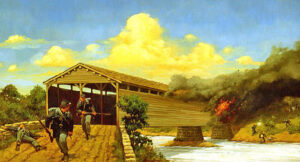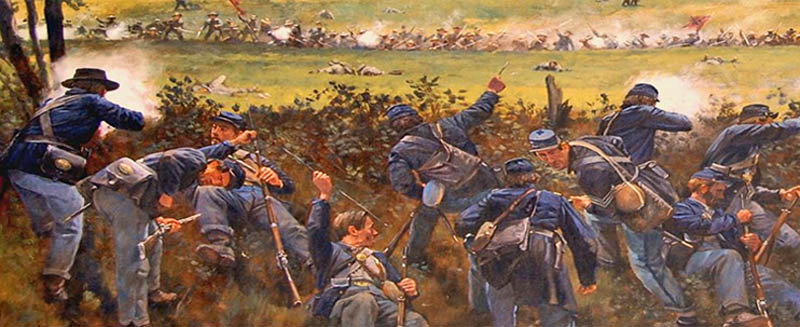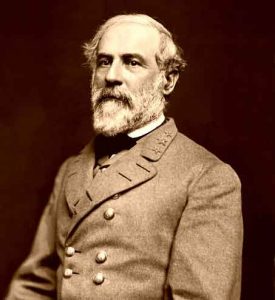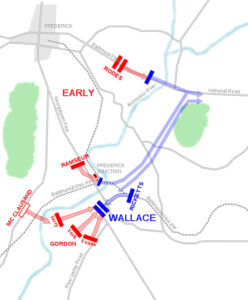The Battle of Monocacy, Maryland, was a Civil War conflict fought on July 9, 1864, as part of the Valley Campaigns.
In the mid-19th century, Frederick, Maryland was a prospering community. Highways leading to Washington, D.C., and Baltimore converged on the city, and the Baltimore & Ohio Railroad ran nearby. This transportation hub became a target for Union and Confederate troops throughout the Civil War.
During the September 1862 Maryland Campaign culminating in the Battle of Antietam, Confederate General Robert E. Lee and his troops camped on the Best Farm. There, Lee wrote Special Order 191, detailing his plans to divide his army and capture Harpers Ferry. A few days later, Union troops camped in the area and discovered a lost copy of the special order.
The plans were shown to Union General George B. McClellan, who then quickened his pace to engage the Confederates at South Mountain on September 14, 1862, and Antietam on September 17, 1862. Later in the war, in June 1863, Union troops moved through the Monocacy region before the Battle of Gettysburg, Pennsylvania. General Winfield Scott Hancock made the Thomas House his headquarters for several days while soldiers were encamped on the Best Farm.
In the summer of 1864, the Civil War was still far from conclusion. Union and Confederate armies were still spread out across the country, with battles and campaigns racking up casualties by the thousands. With Union forces under Lieutenant General Ulysses S. Grant deep in Virginia at Petersburg, Confederate General Robert E. Lee devised a bold plan. Lee ordered General Jubal Early to take the Second Corps of the Army of Northern Virginia and link up with General John C. Breckenridge to clear the Shenandoah Valley. After securing the Valley, Early was to invade Maryland, putting pressure on the Federal capital in Washington, D.C. By the first week of July, Confederates had entered Maryland and caught Union forces largely off guard.
As the Federals scrambled to gather a defensive force, Major General Lew Wallace and roughly 3,200 inexperienced troops of the Middle Department headed west from Baltimore, Maryland. They took up a position just south of Frederick, Maryland, at Monocacy Junction along the Monocacy River. General Grant ordered the third division of the Sixth Corps north, hoping they would reach Maryland in time to slow Early’s advance. By the morning of July 9, nearly 6,600 Union troops had gathered near Monocacy Junction, with Wallace in command. Early’s 15,000 Confederates were to the north in Frederick. The stage for battle was set.
About six miles from Frederick, Maryland, the Battle of Monocacy began around 8:30 a.m. when Confederate troops, commanded by General Stephen Ramseur, advanced south along the Georgetown Pike and encountered Union infantry near Monocacy Junction. Wallace placed his men north of Monocacy Junction and on a wooden covered bridge that carried the pike over the Monocacy River, blocking Early’s best route to Washington. Ramseur’s division continued to pressure Union forces near Monocacy Junction throughout the day, but they could not drive back the Union defense, composed of troops from Maryland and Vermont.

Covered Bridge over the Monocacy River, courtesy Army Historical Foundation.
After encountering resistance near Monocacy Junction, Confederates sought another way to cross the river. Confederate General John McCausland’s cavalrymen found the Worthington Ford almost a mile downriver of the wooden covered bridge and, by 10:30 a.m., had begun to cross, placing pressure on Wallace’s forces south of the river. When Wallace learned of the Confederate presence south of the Monocacy, he ordered the wooden covered bridge burned to protect his new right flank as he shifted his main battle lines to the west onto the Thomas Farm.
The first Confederate attack south of the Monocacy began around 11:00 a.m., as McCausland’s men advanced east and encountered Federal infantry from Union General James Ricketts’s Sixth Corps division. McCausland was repulsed and formed for another attack around 2:00 p.m., moving from the Worthington Farm toward the Thomas House. While the Confederates gained control of the Thomas Farm, Federal forces soon pushed back in a savage counterattack.
Amid McCausland’s second cavalry attack, help was coming for the Confederates. Confederate General John B. Gordon’s division forded the Monocacy River using the Worthington Ford and, by mid-afternoon, was ready to attack. Near 3:30 p.m., Gordon’s three brigades swept forward en echelon from right, moving from Brooks Hill toward the Union line on the Thomas Farm. The fighting was fierce, with heavy casualties falling on both sides. The Union battle line began to waver and then fell back toward the Georgetown Pike. Confederates could threaten and eventually turn the Union’s right flank; Wallace had no choice but to retreat from the field to save his remaining men. By 5:00 p.m., the Federals were fully retreating to the east, and Confederates would take the field. During the fighting, roughly 2,200 men were killed, wounded, captured, or listed as missing, of which 900 were Confederate and 1,300 were Union.
While the Confederates had won the Battle of Monocacy, Lew Wallace was ultimately successful. His efforts had delayed Jubal Early’s advance long enough for additional Union reinforcements to reach Washington, D.C. When Early’s men reached the capital on July 11, help had arrived in the Federal capital. Some fighting and skirmishing occurred near Fort Stevens on the city’s outskirts, but Early could not take Washington. With their campaign over, he and his men withdrew back into Maryland and eventually crossed the Potomac River back into Virginia.
Today, the Monocacy National Battlefield near Frederick, Maryland, commemorates the battle and Civil War history. The site comprises 1,647 acres of farmland, forest, and coastal areas in the Monocacy River Valley. The park includes six historic properties: the Baker, Best, Lewis, Thomas, and Worthington farms, as well as the Gambrill Mill and House. In the early 20th Century, Civil War Veterans and the United Daughters of the Confederacy built monuments to commemorate the Battle of Monocacy.
More Information:
Monocacy National Battlefield
5201 Urbana Pike
Frederick, Maryland 21704
Compiled Kathy Alexander/Legends of America, March 2024.
Also See:
Maryland Campaign & Battles of the Civil War
Sources:



